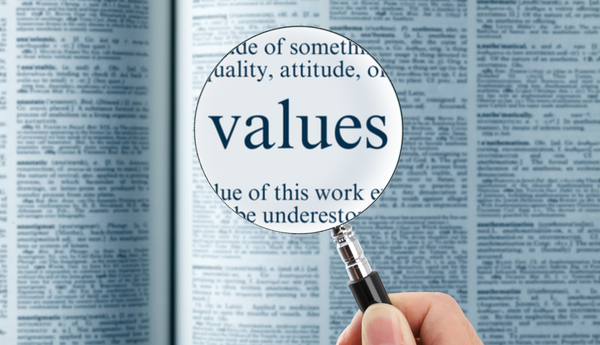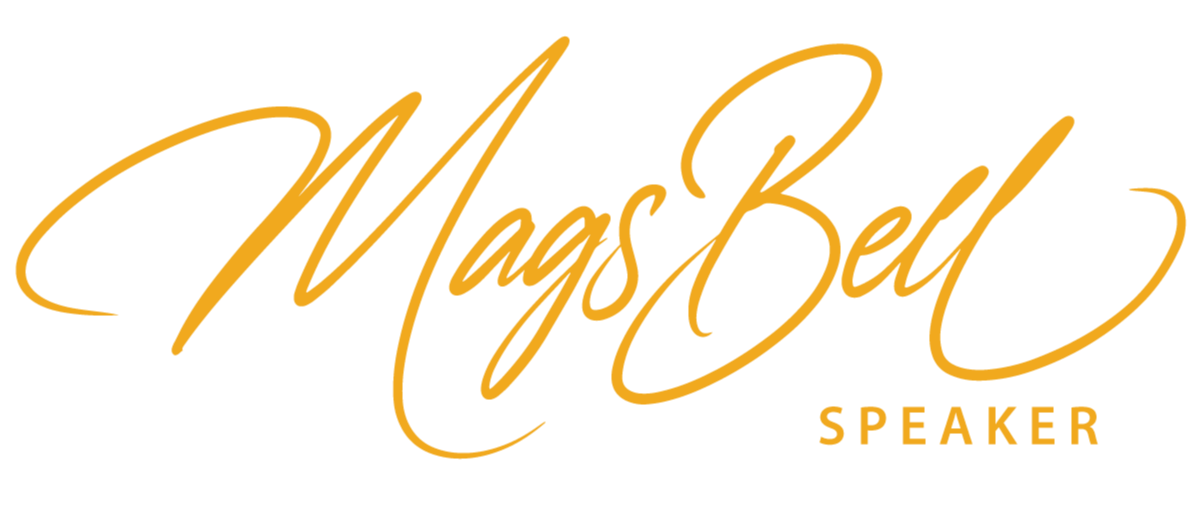3 Practical Tips to Help with the Scary Things in Life

There’s plenty going on in the world right now that’s making people feel anxious, overwhelmed, and just downright stressed. I’ve had so many people say to me, Mags, “these are scary times. My anxiety is through the roof. I’m struggling to deal with everything happening in the world.” We’re seeing natural disasters, political upheaval, wars—all sorts of chaos. And because we’re empathetic beings, we feel it. But here’s the thing: how well you manage this depends on your boundaries. And let’s face it, most people’s boundaries are about as solid as a wet paper bag. I used to be the same, but once I nailed my boundaries, everything changed. So, let’s talk about three key things you can do right now to calm your mind and take back control. The LeadingME® Ladder of Leadership The LeadingME® Ladder of Leadership is all about managing your ego and finding balance. In the middle of the ladder, we have the space where you’re leading yourself—where you’re confident, centred, and response-able. That’s where you want to be. But if you’re not there, you’re either trying to control everything (big ego) or feeling completely powerless (victim mode). Neither of those places is good for you. The trick? Get out of the movie. When you’re in the thick of it, reacting to everything, you’re in the movie. You need to step back and become the observer. That way, you can choose your response instead of being dragged around by your emotions. If you find yourself caught up in fear, judgement, or overwhelm, use the 4R’s Release Model® or the 3 Keys to Eliminate Your Shite™. These tools help you get back into that balanced LeadingME® space where you’re in control of yourself and your reactions. Take Control with Breath Work Your breath is your greatest tool. It’s the one thing that’s with you from the moment you enter this world until the moment you leave it. And yet, most people don’t use it properly. Breathwork is a simple but powerful way to reset your nervous system. When anxiety and stress kick in, your breathing changes—usually becoming shallow and fast. But when you control your breath, you control your state. Try yogic belly breathing: Get into a relaxed position place your hand on your heart and bring your attention to your breath Inhale deeply through your nose, expanding your belly. Exhale slowly through your mouth, for longer than you inhaled. At the bottom of that exhale Hold your breath for a few seconds. Repeat for 5/10 breaths or until you feel calm and relaxed. (You can see a demonstration on the YouTube Video here) Doing this regularly will help you stay calm, focused, and in control. If you need guidance, check out the Breathing App—it’s a great tool to help you regulate your breathing. Calm Your Nerves with Meditation I used to make excuses for why I couldn’t meditate—my mind is too busy, I don’t have time. Sound familiar? But here’s the truth: meditation isn’t about trying to stop your thoughts. It’s about not letting them control you. Start with guided meditations. There are loads available on YouTube, Spotify, and various apps. Just search for relaxation guided meditation and follow along. ONLY if you are ready and have been meditating for a while and feel the need to take it up a notch, try a Vipassana retreat—ten days of silent meditation. It’s intense but life-changing. That’s where LeadingME® was truly born for me. But you don’t need to go that far—just start with five minutes a day. And remember, it’s not about getting it perfect. It’s like any other skill we need to learn by showing up for yourself and practising. Fear Less, Shine More Change is happening, and whether it feels chaotic or promising, it’s moving us forward. Sometimes, the old structures need to fall before we can truly build something new. And while that may look messy, it’s in these moments that we have a choice—be pulled into the fear or step into our own power, wisdom and knowing. Stepping into LOVE You have the power to choose how you move forward. And right now, choosing yourself is more important than ever. And if you’re ready for more support, come join us in the Dare to Shine Your Brilliance Community — we’d love to have you! One of the powerful tools we use is Decision Making Made Easy, designed to help you gain clarity by working through your outcomes, vision, values, and purpose. When you align with your values, setting boundaries and making strong decisions becomes second nature. As always, Stay True, Stay YouAnd Keep Bringing Out Your Brilliance!
Do You React When You Hear the Word ‘Ego’?

Have you ever noticed how the word ego makes people uncomfortable? I certainly did during a recent conversation about the LeadingME® Ladder of Leadership. It struck me how often people push the word away, treating ego like the enemy. But what if we’ve been looking at it all wrong? Let’s dig into this and challenge the stories we’ve told ourselves about ego. Understanding the LeadingME® Ladder of Leadership The LeadingME® Ladder of Leadership isn’t a conventional ladder that goes up and down. Instead, it moves from both sides into the centre, which I call “LeadingME®.” This central space represents balance, accountability, emotional responsibility, flow, love and kindness, etc. Sometimes, we operate from this balanced state, but other times, we drift away from it. When we’re not in this balanced space, we find ourselves in two extremes: To bring ourselves back to the centre, I use two tools: Why Does the Word ‘Ego’ Trigger Some People? During the conversation I mentioned earlier, the person I was speaking with became defensive at the word “ego.” This wasn’t the first time, either. Despite previous discussions, they continued to resist the term. So, why do we react to the word “ego”? Many people associate it with arrogance or selfishness, giving it a negative reputation. However, ego itself isn’t bad, we all have one — it’s only problematic when it’s unbalanced. When we master our ego and operate from the centre, we achieve flow. When it’s unbalanced, it leads to stress, anxiety, and destructive behaviours. It’s where all our mental health issues stem from. The Movie Analogy: Are You In or Out of the movie? Think about watching a movie. When you’re fully immersed, you react automatically—laughing, crying, gasping and jumping at scary points. But the moment you hear someone rustling a popcorn bag, you snap out of the movie and become aware of your surroundings. Now, you can see both the film and the bigger picture. The same concept applies to the ego. If you react strongly to the word “ego,” ask yourself: Am I stuck in the movie? When you’re deeply immersed in your own narrative, you’re either bigging it up or belittling yourself. But when you step back, you gain control over your reactions and can choose how to respond. Ego: Friend or Foe? Many people think ego is a bad thing. I hear it all the time: “Leave your ego at the door.” But what does that really mean? That we should suppress ourselves? Shrink to fit in? No! We cannot leave the ego behind it is part of us and we need to accept that. Ego itself isn’t bad—it’s how we manage it. When we allow ego to control us, it manifests in two extremes: • Bigging It Up – This is when we judge, control, or assert dominance. “I’m right, you’re wrong.” • Belittling – This is the blame, victim mindset. “You don’t understand what I’ve been through.” “I didn’t do it that was not my responsibility, it was theirs.” Both are unbalanced states. But when we master our ego, we sit in the middle ground, where we can make conscious choices and take responsibility for our reactions. That’s where leadership, confidence, and true self-awareness live. Releasing the Stories That Hold You Back A huge part of balancing ego is letting go of the stories we’ve carried for years—often since childhood. We all have experiences that shaped our reactions, and sometimes, those experiences left emotional imprints that still play out today. Trauma isn’t just the big things. It’s anything that affected you deeply. Even siblings growing up in the same household can have completely different experiences of the same event. The key is recognising those emotional imprints and finding ways to release them. There are many ways to do this: breathwork, meditation, inner child work, and tools like my Three Keys to Eliminate Your Shite and 4R’s Release Model®. These methods help clear the emotional blocks that keep us stuck in old patterns. What’s Your Relationship with Ego? I encourage you to reflect: • Do you resist the word “ego”? • Do you blame others for their ego while ignoring your own? The mirror effect. • Are you bigging it up or belittling yourself? • Does your ego influence your daily choices or are you the master of your own ego? If you find yourself reacting negatively, consider doing some inner work. Join our Dare to Shine Your Brilliance Community, where we explore these topics together and support each other’s growth. Owning Your Flaws, Finding Your Flow Trust me, I’ve been relying on my tools a lot lately. The start of this year threw some big challenges my way, and I’m still navigating and processing them. I’m not a perfect being—but I am the perfect me. And as George R.R. Martin (paraphrased) said, when we fully own our flaws, no one can use them against us. That’s the key—accepting our flows and then working with them, not against them. When you understand that, life flows more easily. So embrace your ego, but aim for balance. When it feels off, ground yourself. Step away, take a breath, reset. The more we release, the lighter life becomes. Stay True, Stay YouAnd Keep Bringing Out Your Brilliance!
Why Most New Year’s Resolutions Fail

New Year’s resolutions. That time of year when we set out grand intentions, only to watch them crash and burn by February. Why does this keep happening? Our resolutions fail because we don’t actually believe in them. We fear them. We don’t have a bloody clue what we really want because we don’t know who we are. Harsh? Maybe. True? Absolutely. Who the Hell Are You? Here’s what you do when it doesn’t work. You sit down and scribble a list of things you think will make you happy. Why? because someone else has them. Because you think they’ll make your life easier or more fulfilling. But none of it is rooted in who you are. It’s all just pipe dreams, comparison traps, and surface-level wishes. How can you set a meaningful course for your life if you don’t know who the hell you are? What are your values? Not the fluffy shite written on a company wall like “integrity” or “truth” that sound good but means nothing. I’m talking about the real values that make you tick. What’s your purpose? What’s the big vision for your life,10 years from now? If you don’t know these things, it’s no wonder your resolutions fail. You’re charting a path with no bloody map. And the fear is telling you “What if I fail?”, “What if I’m not good enough?” It’s been with you since day one of setting your year’s goals, gripping you, sabotaging your efforts, and whispering in your ear that you’ll never get them. They’re deeply ingrained stories that have been running your life since you were a child, maybe even longer if you believe in past lives. What Are You Avoiding? I’ve heard people say, “I surrendered to my path,” that’s bollocks. You don’t sit back and wait for the universe to hand you a map. It’s about facing the dark parts of yourself—the bits you avoid because they make you squirm. It’s not pretty, it’s not comfortable, and it’ll push every bloody button you’ve got. But that’s where the magic happens. What you can do is start peeling back the layers and ask yourself, “Why is this getting under my skin?” Nine times out of ten, it’s something you’re avoiding in yourself. There are loads of tools to help with this. The Silence Your Inner Critic Free Webinar dives into shutting down sabotaging thoughts. Decision Making Made Easy™ aligns your head, heart, and gut to move you forward. Or Google it—there’s no shortage of ways to start breaking free. Own Your Shite If you’re not ready to face who you are, don’t bother setting resolutions. Seriously, save yourself the time and energy. But if you’re ready, to figure out what you want and stop living someone else’s life, then it’s time to do the work. Get to know your values. Get rid of the fear. Stop telling yourself the same tired stories about why it works for others but not for you. And you don’t have to do it alone. Find Your Tribe We’re in the age of Aquarius, it’s all about community and connection. The world is shifting, and people everywhere are finding their tribes—groups that challenge them, support them, and lift them up. Find yours. Whether it’s a coach, a mentor, or a group of like-minded individuals, surround yourself with people who will push and support your growth. And once you’ve got your tribe, then you can set a course. If you’re looking for that kind of space, the Dare to Shine Your Brilliance Community is here for you — for people ready to do the deeper work, to get clear on who they are and what they want, and to build the tools and resilience to achieve it. Make This Year Different Don’t have this year as just another chance to make resolutions you won’t keep. Make it an opportunity to figure out who you are and what you truly want. Take the time. Do the work. Ask for help if you need it. There’s so much out there to help you: books, videos, tools, and resources everywhere you look. Go on YouTube and explore the places you usually turn to for guidance. The universe is there to support you if you let it. Call it the universe, God, or whatever feels right to you, just ask for help and trust that it will come. This is your year to stop playing small. Go for it! Stay True, Stay YouAnd Keep Bringing Out Your Brilliance!
Why Overwhelm Happens and How You Can Stop Burnout in Its Tracks

Over the years, I’ve found myself overwhelmed more times than I care to admit. Every single time, it happened when I put myself last—when I ignored my values, thinking I was doing what was right for others. It creeps in, subtly, until our ego takes over and pushes us further down the spiral. But what if the key to overcoming overwhelm lies in learning to lead ourselves first? The Day I Realised I Was My Own Problem The American author and podcaster Cheryl Strayed reminds us: “You don’t have a right to the cards you believe you should have been dealt. You have an obligation to play the hell out of the ones that you’re holding.” I learned this the hard way. I tried to be Superwoman, managing work, home, and let overwhelm take over. My advice is – Own your own overwhelm. I remember planning my birthday party, and even though Paul, my partner, offered to handle everything, my inner control freak couldn’t resist meddling. Even on the morning of the party, I insisted on cutting the grass. It was ridiculous. It wasn’t until I saw how well Paul had organised everything that I realised: I created my own overwhelm. Owning your overwhelm means owning that you caused it. What Happens When Overwhelm Takes Over Your Body? Overwhelm can reach a point where it affects us physically, emotionally, and mentally and eventually leads to burnout. I share this not as a badge of honour but as a warning: Don’t let it consume you. When overwhelm hits, it doesn’t just affect our productivity — it clouds our mind with brain fog, drags our emotions all over the place, and can even affect our health. That’s why it’s called dis-ease. Glennon Doyle wisely says, “You can’t save your face and your ass at the same time. Let yourself fall apart.” It’s okay to fall apart. Give yourself the space to recharge, take care of your mental and emotional health, and let your body heal. You can’t pour from an empty cup. The LeadingME® Ladder of Leadership LeadingME® emerged from the journey to understand ME — what makes us tick, how our ego affects us, and how it influences our behavior. The LeadingME® Ladder of Leadership shows how the extremes of ego, either “bigging it up” or “belittling”, pull us away from our centre. But true balance lies in the middle, where nurturing, self-awareness, and responsibility meet. The key to overcoming this is recognising when our ego is controlling us—through thoughts like “I have to do this” or “I should do that.” Alternatively, falling into a “poor me” mindset, blaming others or feeling victimised. The Power of Taking a Break and Setting Boundaries When it comes to managing overwhelm, take a break and set boundaries because it’s bloody important. And the first person you need to set boundaries with is yourself. We often take on too much, trying to prove something to ourselves but it all starts with living by our values. We have to sit with ourselves and really ask, “What am I doing to myself? What’s the cause of this? “ If you can’t figure it out alone, talk to someone — a mentor, a coach, a trusted friend, someone who can step outside of your “movie” and see things clearly. But whatever you do, stop blaming others. Own your overwhelm, pause, and refocus before burnout takes over. Own Your Overwhelm by Being in the Present It doesn’t just mean stopping for a moment to catch your breath. It means prioritising meditation, walking in nature, exercise, reading, yoga — whatever works for you. Eckhart Tolle says, “When you are overwhelmed by the future… and the past, you have lost the present.” Overwhelm happens when we stop being in the now. So, stop and listen. Smell the roses, go for a walk in nature. If you’re feeling overwhelmed, it’s time to really pause and ask yourself: Where’s it coming from? Is it physical? Emotional? Mental? Maybe it’s all three, but if you’ve hit burnout. Take action. We all have been there. I used to think I was invincible, too. And I’m not. And neither are you. Stay True, Stay YouAnd Keep Bringing Out Your Brilliance!
Transforming Doubt into Leadership Strength: How To Overcome Doubt For Lasting Success

Doubt—we all know that feeling. Whether it’s the voice inside telling us we’re not good enough, or the external pressures pushing us in directions that don’t feel right, doubt can feel like an obstacle. Yet, doubt also has a unique power to make us pause, reflect, and focus on what truly matters. What if doubt could be both the weight we shed and the force that lifts us up? Doubt as a Double-Edged Sword Doubt shows up in different forms. It can manifest as the fear that holds us back or as pressure from societal expectations. I remember a time when, despite accolades and awards, I was haunted by a quiet, unrelenting feeling that I didn’t measure up. It didn’t matter what others said. That inner critic had me convinced I was lacking, and eventually, it crept into my body as a dis-ease, a heaviness I couldn’t shake. But doubt can also protect us. It’s the instinct that says “no” when the world around you is pushing you toward “yes.” I remember feeling pressured to stay in a relationship, fearing others’ disappointment more than trusting my own instincts. That doubt reminded me to stay true to myself. Can Doubt Be Both Limiting & Empowering? Doubt can feel limiting, especially when it leads to excessive self-questioning, indecision and procrastination. But it also has an empowering side. It was the shifting between the balanced/unbalanced ego, filling me with certainty in one breath, and pulling me down with doubt in the next. I didn’t realise it at the time, but that back-and-forth was shaping me, helping me refine what truly mattered. Bertrand Russell said it well, “The whole problem with the world is that fools and fanatics are always so certain of themselves… and wiser people are full of doubts.” The beliefs I held when I was younger are not the ones I hold now, and that’s a testament to doubt’s transformative power. In my younger years, I thought I had all the answers. The LeadingME® Ladder of Leadership Doubt has made me a lifelong learner. Today, I welcome doubt. It helps us challenge our assumptions and stay open to new ideas, allowing us to grow. The LeadingME® Ladder of Leadership talks about the importance of balance. It’s easy to fall into the extremes of overconfidence or excessive self-doubt, but true strength lies in that middle ground. That middle ground, or as I call it ‘LeadingME® where we engage with doubt just enough to stay humble, aware, and open to learning. When we live in that centre-ground, we’re not afraid to ask questions, to see things from multiple angles, and to evolve. Overcoming Doubt Requires Courage & Action Doubt doesn’t disappear on its own. As Charles Bukowski put it, “Doubt is only removed by action.” To transform doubt into strength, we have to meet it head-on, taking small, focused actions, we can’t sit back and hope for confidence to find us. So, when doubt arises, take a moment to ask yourself: Where is this doubt coming from? What does it reveal about my path forward? This honest self-inquiry transforms doubt from a barrier into a motivator. It’s a central idea in the Silencing Your Inner Critic free webinar, where we guide people through the 4Rs Release Model®. When doubt is met with courage, it becomes a strength. Embracing Doubt as Your Greatest Leadership Tool Doubt is neither negative nor positive—it just is. Sometimes, it’s calling us to let go of what no longer serves us. Other times, it’s asking us to see something from a new perspective. So, the next time doubt appears, don’t ignore it. Instead, pause, reflect, and let it guide you. Let it lead you back to your values, to your happiness and to what matters most to you. Each time you choose courage over hesitation, you’re not just overcoming doubt—you’re stepping into your brilliance. Doubt is a reminder that we are on a constant journey to become who we’re meant to be. Stay True, Stay YouAnd Keep Bringing Out Your Brilliance!
From Insecurity to Influence: Lead with Confidence by Embracing Your Values

How often have you felt stuck, unsure of your next move, caught in a whirlwind of opinions and external pressures? Values are at the core of every choice we make—they guide our decisions, shape our identity, and define the connections we build. Without a clear understanding of your core values, you’ll drift—unanchored and second-guessing every step. I had to learn this the hard way, and I’ll never forget the lesson. Why Every Decision Starts with Your Values Many moons ago, I was headhunted for a role that seemed perfect. The company’s values, which looked great on its website, didn’t align with what I experienced. I had not done my due diligence well enough, and, more importantly, I didn’t fully understand my own values at the time either. But after accepting the job, I quickly realised something was wrong. I stayed for two years, but it was a struggle for me emotionally even as I was winning awards and successful in everyone else’s eyes. Looking back, I learned the importance of knowing my values before making any decision. The LeadingME® Ladder of Leadership As I often discuss in the LeadingME® Ladder of Leadership, we can fall into the trap of either ‘bigging it up’—where ego leads us to a false overconfidence—or ‘belittling ourselves’ through self-doubt and blame. In this case, my ego was definitely in control. I didn’t have the clarity to see that this wasn’t the right environment for me, all because I didn’t truly know what was driving me. And without knowing my values, I couldn’t make the best decisions for myself. Mahatma Gandhi summed it up perfectly: “Your beliefs become your thoughts, your thoughts become your words, your words become your actions, your actions become your habits, your habits become your values, and your values become your destiny.” In short, your values shape your entire life. If you don’t know what they are, how can you confidently navigate the world and live with purpose? Building Meaningful Relationships Through Values Knowing your values also helps you determine the relationships and environments where you thrive. I’ve often noticed that the strongest connections I’ve made—whether personal or professional—were with people who shared similar values. When I look for clients or collaborators, I make sure we share similar values. Without that foundation, it’s hard to build a meaningful relationship. Values help you decide who to keep in your circle and which environments will bring out your best. Embracing Your Values for Confidence and Clarity Your values are the foundation of everything you do—from the decisions you make to the relationships you build. If you’re feeling lost or unsure of your direction, take a step back and spend some time getting clear on your core values. They are your internal compass, guiding you toward a life of purpose, confidence, and brilliance. If you want to dive deeper and explore how values, purpose, and vision come together, check out my Decision Making Made Easy™ online course. It’s designed to help you go from insecurity to influence by embracing your values and leading with confidence. Stay True, Stay YouAnd Keep Bringing Out Your Brilliance!
Dare to Shine: Bringing Out Your Brilliance

Marianne Williamson beautifully said, “Our deepest fear is that we are powerful beyond measure.” I absolutely love this, because it gets to the core of why so many of us hold back. We find ourselves asking, “Who am I to be brilliant, gorgeous, talented, fabulous?” But really, who are you not to be? What if you stopped playing small and dared to embrace your full brilliance? What’s Stopping You From Shining? Most of us live with a hidden fear— not always of failure but the potential of how brilliant we could be. Think about a diamond formed under immense pressure and heat. We, too, are forged through the challenges life throws at us. Just as a diamond becomes more brilliant by cutting and polishing, so too do we when we cut, polish, and reset our inner diamonds. But What is This Inner Diamond? It’s where our brilliance resides. For those familiar with my Decision Making Made Easy™ programme, you know that I talk about the importance of aligning your head (vision), heart (purpose), and gut (values). When these three are in harmony, we shine more brightly in everything we do. We lead with clarity, resilience, and confidence. Authenticity Comes From Within True brilliance doesn’t come from faking it—it comes from embracing who you truly are. We often hear “fake it until you make it,” but the truth is, real confidence comes from authenticity. It’s not about pretending to be someone else; it’s about aligning your actions with your values, purpose and vision. When I study something, like learning a new language, I don’t fake it—I believe in my ability to become fluent. The power of belief is transformative, but only when it’s grounded in authenticity. The LeadingME® Ladder of Leadership On the LeadingME® Ladder of Leadership, it’s easy to sway between ‘bigging it up’ (overconfidence) and ‘belittling yourself’ (self-doubt). Brilliance comes when you embrace all of who you are. It’s not about showing off or thinking you’re better than others. In fact, focusing only on “bigging yourself up” leads to the opposite, it leads to belittling yourself. We live in a world of polarity, and when you tip to one extreme, the other follows. True leadership is found in the middle ground, where we can lead with our authentic selves, grounded in our purpose. This balance starts with embracing all parts of ourselves—both the light and the darkness. Inspire Others with Your Brilliance As George R.R. Martin said, “When you accept your flaws, no one can use them against you.” When you accept both your light and your darkness, you step into your full brilliance—authentic, unshaken, and ready to shine. Your brilliance is not just for you, it’s for the world. When you lead with compassion, generosity, and authenticity, you create space for others to shine, too. Simple acts of appreciation—a kind word, a smile, or recognising someone’s efforts—help others feel seen, valued, and inspired. So dare to shine. The world needs your brilliance and by stepping into your light, you give others permission to do the same. Stay True, Stay YouAnd Keep Bringing Out Your Brilliance!
Discovering Your True Purpose

Throughout my years of coaching and mentoring, I’ve found that no matter who I asked, from new starters to top executives, most struggle to define their purpose. After all, if you’re unsure about your purpose, how can you effectively chart a path to where you want to be? So, What Exactly is ‘Purpose’? What does purpose look like, and how do you know if you’ve found it? Knowing your purpose is like having a personal GPS, guiding your decisions and actions to align perfectly with your core values and your vision. At its simplest, purpose is the passion for doing something you deeply love. It’s the belief that you can make a difference, not necessarily through your job, though it’s ideal if your career aligns with this passion. Sharing knowledge, experience and tools, that help others find their pathway—that’s what I love. It’s true what they say: find what you love, and you’ll never work a day in your life. Purpose as Your Compass Purpose isn’t just a nice-to-have—it’s essential. It provides focus and direction. We often find ourselves pursuing goals set by others, but do these align with our own? If not, we’re likely on the wrong path. Purpose ensures that what’s right for us aligns with what we do, benefiting us and those around us. This is an ingredient of LeadingME® – leading yourself effectively ensures that others will follow by example. This alignment creates ease in what we do, enhancing both motivation and resilience—qualities often lacking in those without a clear purpose. The LeadingME® Ladder of Leadership Imagine leadership as a ladder not just reaching upwards but spanning side to side. On one side, we’re bigging it up; on the other, we’re belittling ourselves. The goal is to balance in the middle, leading from a place of true self. This middle ground is where mental and emotional health thrive. Here, I am grounded in kindness and love, appreciating life fully. Knowing my values, understanding my purpose, and working towards a vision that resonates deeply with who I am—this is where genuine leadership flourishes. Without this understanding, we’re merely contributing to the noise, risking our mental well-being. Aristotle and Ikigai: A Universal Search for Purpose The great Greek Philosopher Aristotle once said, “Where your talents and the needs of the world cross, there lies your vocation.” In essence, he’s speaking about purpose. Likewise, the Japanese concept of Ikigai offers a similar perspective, suggesting that our true calling lies at the intersection of what we love, what we’re good at, what the world needs, and what we can be paid for. However, this last point needs your limiting beliefs to be put aside. Finding this intersection isn’t just about answering these questions on the surface—it requires a deep, introspective dive to discover what truly drives us beyond superficial desires or expectations. Embracing Your Journey Identifying and embracing your purpose transforms more than just your career—it enriches your entire existence. It influences how you interact with others, the satisfaction you derive from daily activities, and your mental and emotional health. If you are reading this and need some help, I developed an online course, “Decision Making Made Easy™,” which consists of a six-step strategy for easy decision-making, which includes clarifying your values, purpose, and vision. So, let’s continue to explore, define, and refine our purposes. Our purpose changes over our lifetime, so check in with yours. After all, it’s not just about finding where we fit in the world—it’s about making the place where we stand truly ours. Stay True, Stay YouAnd Keep Bringing Out Your Brilliance!
Introvert’s Strength Behind Their Quiet Demeanour

What pops into your head when you hear the word “introvert”? Maybe you’re nodding because that’s totally you, enjoying your quiet time. Or perhaps you’re still figuring out exactly what an introvert is. Maybe you’re an extrovert trying to understand an introverted colleague, friend or family member. Whatever your connection, I invite you to reflect on what “introvert” means to you. Today, we’re diving into the world of introverts— not just to understand them but to celebrate their quiet strength. Even though they might not always speak up, their silence can speak volumes. Let’s explore three key areas where introverts stand out. 3 Key Strengths of Introverts 1. Deep Thinking & Problem Solving Introverted individuals often delve deeply into their thoughts, sometimes leading to friction. However, once you realise that this depth is their superpower and something they truly embrace, it’s incredible. Connecting the dots comes naturally to introverts. They enjoy seeing how things align and predicting potential outcomes, often thinking several steps ahead. I remember countless meetings in which everyone actively discussed and brainstormed while the introverts quietly observed. Then, they would gently pause our discussions to point out potential issues they’d foreseen, saying, “I see where you’re going, but what about this?” While we were all charging ahead, they had already spotted the roadblocks. When they pointed these out, it would hit us—oh yes, that’s true, we need to rethink this. 2. Excellent Listening Skills Introverts are naturally gifted listeners. They tend to analyse and reflect on things deeply, which leads them to observe and listen rather than dominate conversations—a common trait among extroverts. This ability to listen attentively is a superpower that allows introverts to build strong, connected relationships. People inherently crave to be listened to, and introverts excel at not just hearing but truly understanding and responding thoughtfully. As an extrovert, I’ve had to learn to hone my listening skills, something that introverts do effortlessly. This is an amazing power to have, as many of us have to learn to listen, but for introverts, it’s just a natural skill. 3. Attention to Detail The last trait I want to highlight is the remarkable attention to detail that introverts possess. I deeply appreciate this quality, especially since my own attention to detail isn’t as sharp. I often rely on introverted team members to review work because they effortlessly catch errors and see nuances I might miss. Their ability to spot patterns and understand the minutiae sets them apart. This skill makes them invaluable in roles that require precision, such as research, writing, and project management. However, their talents extend beyond analytical tasks; for example, I have an amazing designer on my team whose attention to detail makes her designs stand out spectacularly. Susan Cain, author of Quiet: The Power of Introverts in a World That Can’t Stop Talking, asserts that there is zero correlation between being the best talker and having the best ideas. This insight challenges the common perception that eloquence is linked to intelligence or creativity. The LeadingME® Ladder of Leadership In the LeadingME® Ladder of Leadership concept, we visualise the ego coming from both sides, ‘Bigging’ and ‘Belittling’ to converging in the middle LeadingME®. This middle part is where personal leadership, or ‘LeadingME® ‘balance resides. Introverts often find themselves on the side of the ladder that leans towards belittling themselves, particularly when they’re reluctant to speak up. This self-belittlement aligns with feelings of inadequacy or blaming themselves. It’s crucial for introverts to recognise this tendency and strive to maintain a balance, ensuring they acknowledge and leverage their abilities in their leadership journey. Michaela Chung, the author of The Irresistible Introvert, emphasises that introverts deeply value the close relationships they work hard to build, often stretching themselves to do so. Unlike extroverts, introverts find it challenging to form these connections. Chung suggests that extroverts should support their introverted peers by helping them find their voice and leverage their unique strengths. Living in Two Worlds Sophie Dembling, author of The Introvert’s Way: A Quiet Life in a Noisy World, describes introverts as living in two worlds. They interact with the world of people but find solace and true belonging in their inner world of solitude. While extroverts may thrive in social environments, introverts often find them exhausting and require time alone to recharge. When extroverts understand this they can help their introverted colleagues, friends and relatives to have that recharging time. Celebrating the Quiet Strength of Introverts To all introverts, I encourage you to take a moment to reflect on the unique insights you possess because of your deep, thoughtful approach. Finding your voice may be a challenge, but it is crucial. We understand it requires effort, but please persist. Your ability to think deeply can also be an issue for you to make a decision. Paralysis by analysis… make sure to stay away from over-analysing. Your contributions are invaluable; without them, we all miss out on so much. Your input is often the magic touch we need. Stay True, Stay YouAnd Keep Bringing Out Your Brilliance!
Failing Forward: Transforming Mistakes Into Milestones

The Irish poet and writer James Joyce said, “Mistakes are the portals of discovery.” I absolutely love that saying because it shifts our perspective on mistakes. Instead of getting wrapped up in the negativity of being wrong, not being perfect, or feeling embarrassed (all belittling on the LeadingME® Ladder of Leadership- see below), we can view mistakes as opportunities for discovery and growth. Reflecting on our past mistakes, we often find that what seemed catastrophic at the time led us to where we are today. But what does failing mean, and what can you do to turn mistakes into milestones? What Does Failing Really Mean? Failing means different things to different people. For some, it can be a small setback; for others, it might feel like a huge disaster. Tony Robbins’s book Unlimited Power helped me understand this deeply. I used to have a massive inner critic that constantly told me I wasn’t good enough and that everything had to be perfect. This drove me to achieve great things, but it also caused immense stress and self-doubt. So Why Do We Focus on Failure Instead of Results? It’s all about conditioning. From a young age, we are conditioned by our parents, teachers, friends, and society to fear failure. We are taught that mistakes are bad and that we should avoid them at all costs. Our doubts often arise from the well-intentioned comments and actions of others, who typically mean no harm and act out of a desire to protect us. For instance, when someone tells us, “Don’t do that, it won’t work. I’ll find a better way for you,” they’re trying to shield us from failure. However, this mindset is limiting. The LeadingME® Ladder of Leadership When it comes to the LeadingME® Ladder of Leadership, I was actually ‘bigging’ it up because I was constantly pushing myself to perfection. When I move to one side of the ladder, I start bigging it up. This is where I try to control situations and people, striving for perfection and often falling into the trap of judgment. The law of polarity then pushes me to the other side – ‘belittling.’ Here, I become my own harshest critic, falling into the blame-victim mentality. In the middle section of this ladder lies the true essence of self-leadership. This middle ground is where confidence reigns – not the false bravado of ‘bigging’ it up, but real, authentic confidence that comes from self-awareness, love, kindness and knowing. It’s important to recognise that you must lead yourself before you can effectively lead others. If I am broken, trying to help others will be futile. Hence, this middle ground is where I need to centre myself. Finding Your Inner Balance LeadingME® is fundamentally about being self-aware, taking responsibility and being able to respond effectively to people and situations around you. Mastering Your Ego. When balanced, you’re not caught up in the drama (‘ In the movie’), where reactions are driven by the ego, often manifesting as either excessive self-promotion (‘bigging it up’) or self-diminishment (‘belittling’). To return to a balanced state, it’s essential to, first be aware of where you are on the LeadingME® Ladder of Leadership and then actively decide to change. Tools and strategies are available to help shift our perspectives and behaviours. Instead of getting stuck in a cycle of negative thinking or dwelling on mistakes, consider changing thought processes. JK Rowling once said, “It is impossible to live without failing at something unless you live so cautiously that you might as well not have lived at all, in which case you have failed by default.” This quote encapsulates the idea that playing it safe and avoiding risks is the biggest failure of all. So, while our beliefs are often shaped by conditioning, it’s possible to recondition ourselves. Galvanising Mistakes into Milestones Galvanising mistakes starts with changing our thought process and behaviour. Instead of viewing mistakes through a lens of negativity, we can choose to see them as opportunities for growth and learning. One effective method is the 4Rs Release Model®, which helps us release negative thoughts and emotions associated with mistakes – ‘belittling.’ By reframing our perspective, we can turn what seemed like failures into valuable lessons that guide us toward success. Tony Robbins’ story about a man who faced numerous failures before becoming the President of the United States illustrates this beautifully. This man failed in business, lost elections, and faced personal tragedies, yet he persevered. His journey teaches us that every setback is an opportunity to learn and grow. Failing Forward By Embracing Mistakes Remembering past mistakes, I see how they’ve brought me to better places in life. These weren’t just unwanted results; they were essential for my growth and progress. I often think, “Oh my God, if those things, that I had seen as failures hadn’t happened, then I wouldn’t be where I am today, doing what I love.” This realisation is what makes life so thrilling. Achieving success is not about avoiding mistakes or failures. It’s about embracing them, learning from them, and building on the newfound foundations they provide. It’s about finding your inner LeadingME® balance. This is the essence of failing forward. Stay True, Stay You And Keep Bringing Out Your Brilliance!
